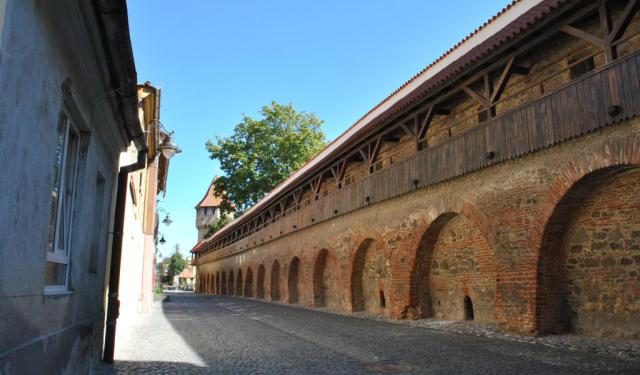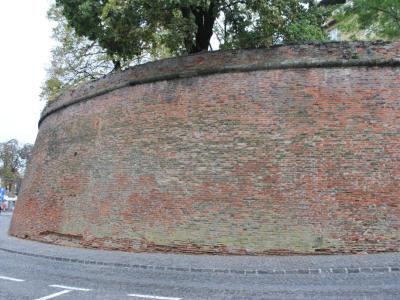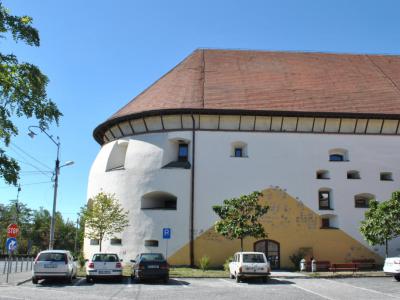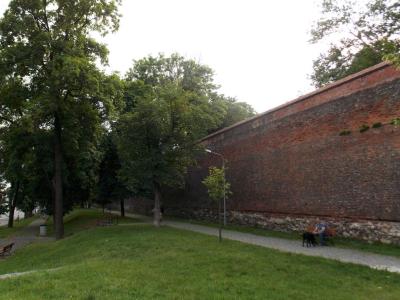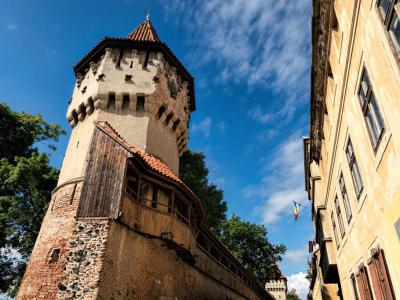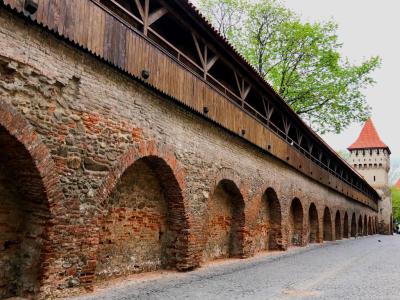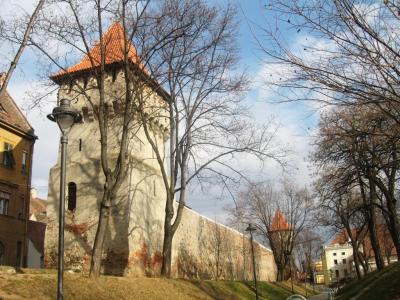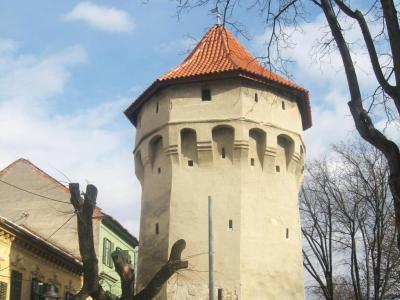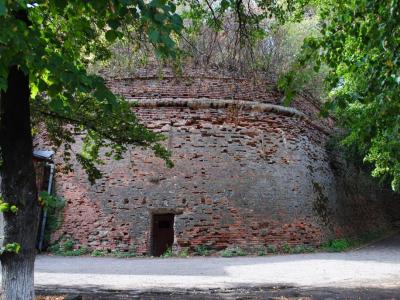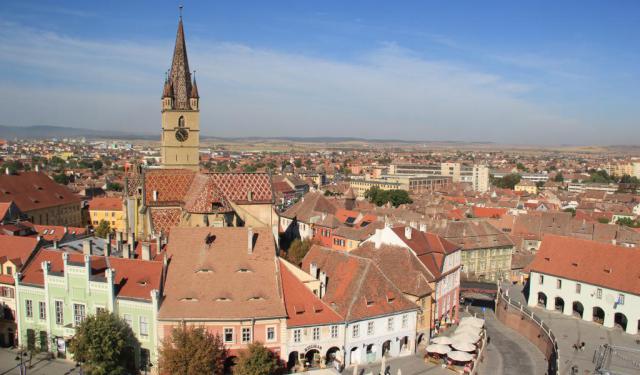Sibiu City Wall and Towers Walking Tour (Self Guided), Sibiu
The historical fortifications of Sibiu hold significant heritage value, offering insights into the city's past and its enduring efforts to protect itself. Unfortunately, for many years, these sites were inaccessible to visitors. Along Fortress Street (Strada Cetății), a collection of towers is linked by a guard corridor, a rare and precious feature that remains the sole example of its kind in Sibiu.
The Haller Bastion (Bastionul Haller) is one of the prominent landmarks within the city's fortifications. It once served as a vital defense point and now accommodates a hospital.
The Thick Tower (Turnul Gros) is another striking feature of Sibiu's defensive architecture. This imposing tower is a part of the city's exterior defense wall, which encircles the historic center and has witnessed much throughout the centuries – a tangible connection to Sibiu's past.
As you explore the ramparts further, you'll encounter more towers, each with its unique character and history. The Carpenters' Tower (Turnul Dulgherilor), Potters' Tower (Turnul Olarilor), and Arquebusiers' Tower (Turnul Archebuzierilor) all contribute to the tapestry of Sibiu's defensive structures.
The Fortress Wall, along with these towers, creates an immersive experience, allowing visitors to imagine life within these walls during medieval times. The Soldiers' Bastion (Bastionul Soldisch) is another integral part of this historical complex, providing insight into the city's strategic defense.
To fully appreciate the City Wall and Towers of Sibiu, take a stroll along these well-preserved fortifications. Our self-guided tour offers you a chance to see these remarkable relics up close and uncover the secrets they hold.
The Haller Bastion (Bastionul Haller) is one of the prominent landmarks within the city's fortifications. It once served as a vital defense point and now accommodates a hospital.
The Thick Tower (Turnul Gros) is another striking feature of Sibiu's defensive architecture. This imposing tower is a part of the city's exterior defense wall, which encircles the historic center and has witnessed much throughout the centuries – a tangible connection to Sibiu's past.
As you explore the ramparts further, you'll encounter more towers, each with its unique character and history. The Carpenters' Tower (Turnul Dulgherilor), Potters' Tower (Turnul Olarilor), and Arquebusiers' Tower (Turnul Archebuzierilor) all contribute to the tapestry of Sibiu's defensive structures.
The Fortress Wall, along with these towers, creates an immersive experience, allowing visitors to imagine life within these walls during medieval times. The Soldiers' Bastion (Bastionul Soldisch) is another integral part of this historical complex, providing insight into the city's strategic defense.
To fully appreciate the City Wall and Towers of Sibiu, take a stroll along these well-preserved fortifications. Our self-guided tour offers you a chance to see these remarkable relics up close and uncover the secrets they hold.
How it works: Download the app "GPSmyCity: Walks in 1K+ Cities" from Apple App Store or Google Play Store to your mobile phone or tablet. The app turns your mobile device into a personal tour guide and its built-in GPS navigation functions guide you from one tour stop to next. The app works offline, so no data plan is needed when traveling abroad.
Sibiu City Wall and Towers Walking Tour Map
Guide Name: Sibiu City Wall and Towers Walking Tour
Guide Location: Romania » Sibiu (See other walking tours in Sibiu)
Guide Type: Self-guided Walking Tour (Sightseeing)
# of Attractions: 8
Tour Duration: 1 Hour(s)
Travel Distance: 1.9 Km or 1.2 Miles
Author: DanaOffice
Sight(s) Featured in This Guide:
Guide Location: Romania » Sibiu (See other walking tours in Sibiu)
Guide Type: Self-guided Walking Tour (Sightseeing)
# of Attractions: 8
Tour Duration: 1 Hour(s)
Travel Distance: 1.9 Km or 1.2 Miles
Author: DanaOffice
Sight(s) Featured in This Guide:
- Bastionul Haller (The Haller Bastion)
- Turnul Gros (The Thick Tower)
- Exterior Defense Wall
- Turnul Dulgherilor (Carpenters' Tower)
- Zidul Cetatii (Fortress Wall)
- Turnul Olarilor (Potters Tower)
- Turnul Archebuzierilor (Arquebusiers Tower)
- Bastionul Soldisch (Soldisch Bastion)
1) Bastionul Haller (The Haller Bastion)
The Haller Bastion stands as the first-ever bastion built in the city and remains one of Transylvania's oldest, with its construction initiated in 1551 under the oversight of Habsburg military commander Castaldo and architect Alessandro Clippa. Commissioned during the Mayorship of Petru Haller, this bastion served a crucial role in securing the road from Brașov and fortifying the South-Eastern corner of the citadel.
Constructed using brick and soil fill, the Haller Bastion features walls spanning 223 meters and reaching a maximum height of 9 meters, resembling the shape of an ace of spades. Designed for enhanced defense, the walls are strategically equipped with rock spacers approximately 1 meter below the upper limit, preventing the installation of siege ladders.
Preserving its historical significance, the bastion retains openings for cannons, facing both the Thick Tower and Manejului Street, alongside discreet "eyes" concealing the blockhouses that once provided crucial fire cover for the bastion's flanks.
Withstood against sieges during pivotal moments in history, including those in 1602-1603, 1658, and 1704, the Haller Bastion played a pivotal role in defending Sibiu during the 1660 siege led by Gheorgy Rackoczy the 2nd.
In 1771, as its defensive significance waned, the bastion transitioned into a different role under Austrian rule, becoming an equestrianism school. This educational institution persisted until 1911, after which the Public Financial Administration took ownership, transforming the bastion into a midwives school and subsequently a maternity hospital.
Constructed using brick and soil fill, the Haller Bastion features walls spanning 223 meters and reaching a maximum height of 9 meters, resembling the shape of an ace of spades. Designed for enhanced defense, the walls are strategically equipped with rock spacers approximately 1 meter below the upper limit, preventing the installation of siege ladders.
Preserving its historical significance, the bastion retains openings for cannons, facing both the Thick Tower and Manejului Street, alongside discreet "eyes" concealing the blockhouses that once provided crucial fire cover for the bastion's flanks.
Withstood against sieges during pivotal moments in history, including those in 1602-1603, 1658, and 1704, the Haller Bastion played a pivotal role in defending Sibiu during the 1660 siege led by Gheorgy Rackoczy the 2nd.
In 1771, as its defensive significance waned, the bastion transitioned into a different role under Austrian rule, becoming an equestrianism school. This educational institution persisted until 1911, after which the Public Financial Administration took ownership, transforming the bastion into a midwives school and subsequently a maternity hospital.
2) Turnul Gros (The Thick Tower)
The Thick Tower stands as a formidable structure with a semi-circular U-shaped design, projecting approximately 25 meters beyond the outer wall. Constructed around 1540 by Markus Pempfflinger, the royal judge of Sibiu, this tower formed an integral part of the city's fortifications, featuring brick walls with stone foundations and a platform historically designated for cannons.
Internally, the Thick Tower housed blockhouses equipped with firing apertures, and archaeological findings revealed two brick ducts, one serving drainage from the external ditch and the other facilitating communication among defending soldiers. In 1787, under the initiative of Martin Hochmeister, mayor of Sibiu and pioneer of the first Romanian bookstore, the tower incorporated the Thalia Hall. This hall, with rococo styling, hosted the inaugural Romanian theatre and, following a fire in 1826, underwent reconstruction in a Viennese architectural manner.
Throughout its history, the Thalia Hall welcomed Romanian theatre troupes led by luminaries such as Mihail Pascaly, Tardini-Vlădicescu, and Matei Millo. Renowned figures like composer George Enescu also graced its stage. Despite enduring a destructive fire in 1949, the theatre persisted until 1990. Subsequently, between 1990 and 2004, the Sibiu County Council meticulously reconstructed the Thalia Hall, repurposing it to house the State Philharmonic of Sibiu, thereby preserving its legacy as an iconic cultural venue.
Internally, the Thick Tower housed blockhouses equipped with firing apertures, and archaeological findings revealed two brick ducts, one serving drainage from the external ditch and the other facilitating communication among defending soldiers. In 1787, under the initiative of Martin Hochmeister, mayor of Sibiu and pioneer of the first Romanian bookstore, the tower incorporated the Thalia Hall. This hall, with rococo styling, hosted the inaugural Romanian theatre and, following a fire in 1826, underwent reconstruction in a Viennese architectural manner.
Throughout its history, the Thalia Hall welcomed Romanian theatre troupes led by luminaries such as Mihail Pascaly, Tardini-Vlădicescu, and Matei Millo. Renowned figures like composer George Enescu also graced its stage. Despite enduring a destructive fire in 1949, the theatre persisted until 1990. Subsequently, between 1990 and 2004, the Sibiu County Council meticulously reconstructed the Thalia Hall, repurposing it to house the State Philharmonic of Sibiu, thereby preserving its legacy as an iconic cultural venue.
3) Exterior Defense Wall
The Exterior Defense Wall serves as a captivating testament to the city's historical fortifications, prominently showcased along the picturesque Coposu Boulevard. Offering a splendid view of the last fortification belt, this imposing structure is adorned with a green area featuring trees, creating a delightful separation between the sidewalk and the formidable wall.
Originally designed in 1791 and extending from the Haller Bastion to the Thick Tower, the green area evolved into a charming promenade, further stretching to include the Cisnadiei Bastion. Along this enchanting stretch, pedestrians can appreciate the grandeur of the fortifications and immerse themselves in the city's rich history.
At both ends, particularly towards Unirii Square and in proximity to the Thick Tower, the wall exhibits architectural finesse, featuring semicircular arches that graciously allow pedestrian access. This thoughtful design not only preserves the historical integrity of the fortifications but also invites visitors to engage with Sibiu's past.
Noteworthy is the strategic break in the wall located at the crossroad of Filarmonicii Street and Coposu Boulevard. This opening, originally the site of the Corpse Gate established in 1554 during plague epidemics, now facilitates vehicular access. A poignant reminder of the city's response to historical health crises, this break in the wall is a significant landmark.
Across from this gate, where the contemporary hospital's new wing stands today, once existed a cemetery that served the community until the late 19th century. The Exterior Defense Wall, with its captivating arches, lush greenery, and historical significance, stands as a living testament to Sibiu's enduring heritage.
Originally designed in 1791 and extending from the Haller Bastion to the Thick Tower, the green area evolved into a charming promenade, further stretching to include the Cisnadiei Bastion. Along this enchanting stretch, pedestrians can appreciate the grandeur of the fortifications and immerse themselves in the city's rich history.
At both ends, particularly towards Unirii Square and in proximity to the Thick Tower, the wall exhibits architectural finesse, featuring semicircular arches that graciously allow pedestrian access. This thoughtful design not only preserves the historical integrity of the fortifications but also invites visitors to engage with Sibiu's past.
Noteworthy is the strategic break in the wall located at the crossroad of Filarmonicii Street and Coposu Boulevard. This opening, originally the site of the Corpse Gate established in 1554 during plague epidemics, now facilitates vehicular access. A poignant reminder of the city's response to historical health crises, this break in the wall is a significant landmark.
Across from this gate, where the contemporary hospital's new wing stands today, once existed a cemetery that served the community until the late 19th century. The Exterior Defense Wall, with its captivating arches, lush greenery, and historical significance, stands as a living testament to Sibiu's enduring heritage.
4) Turnul Dulgherilor (Carpenters' Tower)
The Carpenters' Tower stands as a testament to medieval craftsmanship in the city of Sibiu. Erected in the 14th century by the Saxon guild of carpenters, this tower played a vital role as part of the third ring of fortifications surrounding the city. Positioned on Cetății Street, it is the northernmost among the trio of towers, along with the Potters' Tower and the Arquebusiers' Tower, creating a formidable defensive line.
This historical structure, part of the third enclosure of Sibiu's medieval fortifications, showcases a harmonious blend of stone and brick construction. The circular base of the Carpenters' Tower gives way to an octagonal prism at the top, adorned with a classic protruding portion supported by intricately designed consoles featuring fire mouths between the arches.
Strategically designed for defense, the tower's first level features keyhole-shaped ramparts, a distinctive architectural feature crafted to facilitate the firing of arquebuses. These openings allowed defenders to unleash firepower upon besiegers attempting to breach the walls. As is characteristic of many towers in Sibiu, the upper portion projects outward and is supported by consoles, each adorned with throwing mouths that served both functional and decorative purposes.
Included in the List of historical monuments in the county of Sibiu since 2004, the Carpenters' Tower stands as a resilient symbol of the city's medieval heritage and the skilled craftsmanship of the Saxon carpenters who contributed to its construction.
This historical structure, part of the third enclosure of Sibiu's medieval fortifications, showcases a harmonious blend of stone and brick construction. The circular base of the Carpenters' Tower gives way to an octagonal prism at the top, adorned with a classic protruding portion supported by intricately designed consoles featuring fire mouths between the arches.
Strategically designed for defense, the tower's first level features keyhole-shaped ramparts, a distinctive architectural feature crafted to facilitate the firing of arquebuses. These openings allowed defenders to unleash firepower upon besiegers attempting to breach the walls. As is characteristic of many towers in Sibiu, the upper portion projects outward and is supported by consoles, each adorned with throwing mouths that served both functional and decorative purposes.
Included in the List of historical monuments in the county of Sibiu since 2004, the Carpenters' Tower stands as a resilient symbol of the city's medieval heritage and the skilled craftsmanship of the Saxon carpenters who contributed to its construction.
5) Zidul Cetatii (Fortress Wall)
The Fortress Wallstands as a resilient testament to the city's medieval heritage, with a particularly captivating segment extending between the Carpenters' Tower and the Potters' Tower. Unlike many sections that fell victim to the "systematization" initiatives of the 19th century, this fragment has retained its authentic character, providing a glimpse into Sibiu's fortified past.
Dating back to the 15th century, this section of the wall underwent a significant reconstruction in bricks, preserving its original charm. The interior of the wall boasts expansive arcades that support a guard path, featuring a wooden parapet and a roof upheld by sturdy wooden poles. This architectural configuration not only served defensive purposes but also created a distinctive visual identity for the fortification.
A unique feature of this Fortress Wall segment is the presence of a balcony-like structure that emerges across from the Carpenters' Tower. Positioned on the inner side of the wall, this balcony contributes to the overall defensive strategy, allowing for enhanced surveillance and strategic positioning.
The Carpenters' Tower itself, situated on the exterior of the wall, plays a crucial role in flanking and fortifying this section. The tower's architectural elements, including the adapted firing holes designed for arquebuses, showcase the evolution of defensive technologies over time. The bulwarks initially crafted for bows have been skillfully modified, reflecting the adaptability and resilience of Sibiu's defensive structures.
Today, as visitors stroll along this well-preserved fragment, they are transported back in time, immersing themselves in the medieval ambiance of Sibiu's Fortress Wall. The harmonious blend of bricks, arcades, and wooden elements not only speaks to the city's history but also stands as a testament to the enduring spirit of its architectural legacy.
Dating back to the 15th century, this section of the wall underwent a significant reconstruction in bricks, preserving its original charm. The interior of the wall boasts expansive arcades that support a guard path, featuring a wooden parapet and a roof upheld by sturdy wooden poles. This architectural configuration not only served defensive purposes but also created a distinctive visual identity for the fortification.
A unique feature of this Fortress Wall segment is the presence of a balcony-like structure that emerges across from the Carpenters' Tower. Positioned on the inner side of the wall, this balcony contributes to the overall defensive strategy, allowing for enhanced surveillance and strategic positioning.
The Carpenters' Tower itself, situated on the exterior of the wall, plays a crucial role in flanking and fortifying this section. The tower's architectural elements, including the adapted firing holes designed for arquebuses, showcase the evolution of defensive technologies over time. The bulwarks initially crafted for bows have been skillfully modified, reflecting the adaptability and resilience of Sibiu's defensive structures.
Today, as visitors stroll along this well-preserved fragment, they are transported back in time, immersing themselves in the medieval ambiance of Sibiu's Fortress Wall. The harmonious blend of bricks, arcades, and wooden elements not only speaks to the city's history but also stands as a testament to the enduring spirit of its architectural legacy.
6) Turnul Olarilor (Potters Tower)
The Potters Tower weaves its history into the architectural fabric of the city. Situated between the Gunsmiths Tower and the Carpenters' Tower, the Potters Tower is intricately connected to the latter through a fortifying wall, marking its place within the precincts of Sibiu's third fortification.
This medieval tower, a testament to the city's resilience, was originally constructed in the 14th century, bearing witness to the passage of time through subsequent alterations and modifications. The current form of the Potters Tower, dating back to the 16th century, reflects the architectural evolution it has undergone.
Crafted from a combination of stone and brick, the tower presents a rectangular shape at its base. As the tower ascends, it undergoes a subtle transformation, shrinking at the intermediate floor before culminating in the classical protuberant portion at the top. This distinctive architectural feature is supported by consoles adorned with fire holes nestled between the arches.
The Potters Tower stands as a testament to the defensive ingenuity of its time. At the first and second levels, keyhole-shaped ramparts are strategically designed to facilitate the firing of harquebuses, underscoring the tower's role in the city's defense. The superior side of the tower exhibits a pronounced protuberance, characteristic of many towers in Sibiu, and is elegantly supported by consoles.
This medieval tower, a testament to the city's resilience, was originally constructed in the 14th century, bearing witness to the passage of time through subsequent alterations and modifications. The current form of the Potters Tower, dating back to the 16th century, reflects the architectural evolution it has undergone.
Crafted from a combination of stone and brick, the tower presents a rectangular shape at its base. As the tower ascends, it undergoes a subtle transformation, shrinking at the intermediate floor before culminating in the classical protuberant portion at the top. This distinctive architectural feature is supported by consoles adorned with fire holes nestled between the arches.
The Potters Tower stands as a testament to the defensive ingenuity of its time. At the first and second levels, keyhole-shaped ramparts are strategically designed to facilitate the firing of harquebuses, underscoring the tower's role in the city's defense. The superior side of the tower exhibits a pronounced protuberance, characteristic of many towers in Sibiu, and is elegantly supported by consoles.
7) Turnul Archebuzierilor (Arquebusiers Tower)
Standing as a unique and significant monument in Sibiu's rich historical tapestry, the Arquebusiers Tower beckons visitors to delve into the city's medieval past.
Reconstructed on an octagonal base, this tower underwent a transformation into the Weavers' Tower, taking its name from the guild that oversaw its administration. Positioned as the southernmost among the trio of towers, it assumes the form of an octagonal prism, distinguished by a protruding upper section supported by arch-adorned consoles featuring firing apertures.
The keyhole-shaped firing openings on the initial level are notable, contributing to the defensive capabilities of the tower. Crafted in stone up to a height of one meter, the tower then transitions to a brick construction for its superior segment. Standing at a height of 20.75 meters, this architectural marvel narrates a tale of structural evolution and guild heritage in the heart of Sibiu.
Unlike its fortified counterparts, The Arquebusiers' Tower stands proudly and independently, disconnected from other towers, adding to its distinctiveness. Rooted in the city's history, the tower served a crucial role as a defensive structure during periods of conflict, safeguarding the heart of Sibiu.
While the city's defensive walls have undergone transformations over time, The Arquebusiers ' Tower endures as a testament to medieval craftsmanship and strategic planning. Situated on Strada Cetății, one of Romania's most picturesque streets, the tower and a section of the surrounding walls stand as silent sentinels, preserving the city's historical legacy.
Reconstructed on an octagonal base, this tower underwent a transformation into the Weavers' Tower, taking its name from the guild that oversaw its administration. Positioned as the southernmost among the trio of towers, it assumes the form of an octagonal prism, distinguished by a protruding upper section supported by arch-adorned consoles featuring firing apertures.
The keyhole-shaped firing openings on the initial level are notable, contributing to the defensive capabilities of the tower. Crafted in stone up to a height of one meter, the tower then transitions to a brick construction for its superior segment. Standing at a height of 20.75 meters, this architectural marvel narrates a tale of structural evolution and guild heritage in the heart of Sibiu.
Unlike its fortified counterparts, The Arquebusiers' Tower stands proudly and independently, disconnected from other towers, adding to its distinctiveness. Rooted in the city's history, the tower served a crucial role as a defensive structure during periods of conflict, safeguarding the heart of Sibiu.
While the city's defensive walls have undergone transformations over time, The Arquebusiers ' Tower endures as a testament to medieval craftsmanship and strategic planning. Situated on Strada Cetății, one of Romania's most picturesque streets, the tower and a section of the surrounding walls stand as silent sentinels, preserving the city's historical legacy.
8) Bastionul Soldisch (Soldisch Bastion)
The Soldisch Bastion, also known as the Bastion of the Mercenaries, stands as a formidable testament to the strategic fortifications of Sibiu. Constructed between 1622 and 1627, this bastion, located at the western extremity of Sibiu's fortifications on Bastionului Street, at the corner with Alba Iulia Road, became an integral part of the city's defensive network.
In the mid-16th century, amid the escalating threat from the Ottoman Empire, Sibiu fortified its defenses with artillery rounds and bastions. The Soldisch Bastion, along with the Haller Bastion, reflects the influence of Italian architects who introduced a new system of fortifications to counter the evolving challenges of warfare. These bastions were strategically positioned to reinforce key points in the city's defensive structure.
Constructed primarily of brick and filled with earth to enhance protection against artillery fire, the Soldisch Bastion exhibits the characteristic features of the Italian fortification system. Despite having the smallest area among the five bastions incorporated into the city's defense belts, the Soldisch Bastion boasts walls with a thickness of 2 meters and a maximum height of 10 meters.
Casemates with openings for cannons were intricately designed into the bastion's structure. Stone spacers, positioned approximately 1 meter from the upper limit of the walls, were strategically added to thwart the placement of siege stairs, enhancing the bastion's defensive capabilities. The pentagonal platform atop the bastion served as the strategic placement for cannons, contributing to the bastion's role in safeguarding the city.
Archaeological findings suggest the presence of a short tunnel beneath the Soldisch Bastion, facilitating communication beyond the walls and adding an intriguing layer to its historical significance.
Out of the five bastions constructed in the second half of the 16th century and the first half of the 17th century, including the Haller Bastion, the bastion in front of the Ocna Gate (Cobblers), the bastion in front of the Tower Gate, and the bastion in front of the Cisnădia Gate, only the Haller and Soldisch bastions have endured the test of time, preserving the rich history of Sibiu's fortifications.
In the mid-16th century, amid the escalating threat from the Ottoman Empire, Sibiu fortified its defenses with artillery rounds and bastions. The Soldisch Bastion, along with the Haller Bastion, reflects the influence of Italian architects who introduced a new system of fortifications to counter the evolving challenges of warfare. These bastions were strategically positioned to reinforce key points in the city's defensive structure.
Constructed primarily of brick and filled with earth to enhance protection against artillery fire, the Soldisch Bastion exhibits the characteristic features of the Italian fortification system. Despite having the smallest area among the five bastions incorporated into the city's defense belts, the Soldisch Bastion boasts walls with a thickness of 2 meters and a maximum height of 10 meters.
Casemates with openings for cannons were intricately designed into the bastion's structure. Stone spacers, positioned approximately 1 meter from the upper limit of the walls, were strategically added to thwart the placement of siege stairs, enhancing the bastion's defensive capabilities. The pentagonal platform atop the bastion served as the strategic placement for cannons, contributing to the bastion's role in safeguarding the city.
Archaeological findings suggest the presence of a short tunnel beneath the Soldisch Bastion, facilitating communication beyond the walls and adding an intriguing layer to its historical significance.
Out of the five bastions constructed in the second half of the 16th century and the first half of the 17th century, including the Haller Bastion, the bastion in front of the Ocna Gate (Cobblers), the bastion in front of the Tower Gate, and the bastion in front of the Cisnădia Gate, only the Haller and Soldisch bastions have endured the test of time, preserving the rich history of Sibiu's fortifications.
Walking Tours in Sibiu, Romania
Create Your Own Walk in Sibiu
Creating your own self-guided walk in Sibiu is easy and fun. Choose the city attractions that you want to see and a walk route map will be created just for you. You can even set your hotel as the start point of the walk.
Sibiu Introduction Walking Tour
Nestled in the heart of Romania's Transylvania, Sibiu is one of the most visited cities in Eastern Europe, and for a good reason! Its ancient beauty restored to its full glory in a historic center can easily steal your heart. Affectionately known as "The Town with Eyes" for its historical buildings with partly open rooftops, the city beckons travelers with its captivating... view more
Tour Duration: 2 Hour(s)
Travel Distance: 2.0 Km or 1.2 Miles
Tour Duration: 2 Hour(s)
Travel Distance: 2.0 Km or 1.2 Miles
The Most Popular Cities
/ view all
